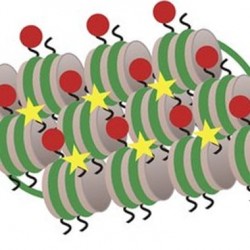By Helen Figueira
April 1, 2013
Time to read: 3 minutes
 A Potential New Treatment for Friedreich’s Ataxia?
A Potential New Treatment for Friedreich’s Ataxia?
Friedreich’s ataxia is a debilitating disease with no cure. A neurodegenerative condition that frequently takes hold in childhood, the inherited condition robs people of their co-ordination and motor functions over time. Speech becomes slurred, mobility impaired to the point of severe disability frequently by the age of 30, and sufferers are at a high risk of diabetes and cardiomyopathy. But novel research from the CSC holds promise for a new therapeutic approach, using a commonly available vitamin supplement to modify the epigenetic controls of the genetic defect causing the illness.
The symptoms of Friedreich’s ataxia are caused by a deficiency in the protein frataxin. A mutation that creates triplets of repeating DNA damages the gene that normally codes for the Frataxin protein, effectively silencing it. Research published in Human Molecular Genetics reveals how this process works, and suggests how it might be tackled. Richard Festenstein (Head of Gene Control Mechanisms and Disease) explains: “The gene silencing is characteristic of something called Position Effect Variegation (PEV) – an archetypal epigenetic phenomenon in which genes are silenced by heterochromatin, and which is sensitive to modifiers.” This realisation opens the door to a potential therapy. If the silencing mechanism can be reversed, expression of that gene could be returned to normal levels.
“We have identified a drug,” says Festenstein, “that switches this gene back on in cells in the correct tissues. In large doses, nicotinamide – vitamin B3 – might be able to restore frataxin levels two- to three-fold, up to asymptomatic levels.” This discovery is the culmination of over a decade’s work for Festenstein. “In 1996 we showed that PEV could happen in a mammal. In 2003 we showed that triplet repeats could induce this type of silencing in vivo in mice.” Now, applying that knowledge to Friedreich’s ataxia has yielded potentially exciting results.
“Nicotinamide is readily available and has a strong safety profile, as it’s already taken as a vitamin supplement,” says Festenstein. So how does it work? For heterochromatin to form, the histone proteins around which the DNA wraps must be methylated. For this to happen, first an acetyl group must be removed. By inhibiting an enzyme that removes the acetyl group, nicotinamide increases acetylation, and therefore lowers the methylation-reducing heterochromatinisation. “We found that the locus was in a more physically open structure after adding nicotinamide. That’s what you’d expect from a gene that is active.”
Reactivating the aberrantly silenced gene could be the key to countering the neurodegeneration experienced by people with Friedreich’s ataxia. Despite the potential, Festenstein remains cautious: “it’s important that patients don’t start taking the drug yet. We’re starting an exploratory clinical trial now, and hopefully that will give us a better idea of whether this could be an effective, safe and reliable treatment.” And this could be the beginning: “with the rise of next-generation sequencing it’s becoming easier to look at the DNA sequences around genes. This could be a prototype for many other diseases. It might be just the tip of the iceberg.”
Reference: Chan, P. K., Torres, R., Yandim, C., Law, P. P., Khadayate, S., Mauri, M., Grosan, C., Chapman-Rothe, N., Giunti, P., Pook, M., Festenstein, R., Mar. 2013. Heterochromatinization induced by GAA-repeat hyperexpansion in friedreich’s ataxia can be reduced upon HDAC inhibition by vitamin b3. Human molecular genetics. | Abstract
AL